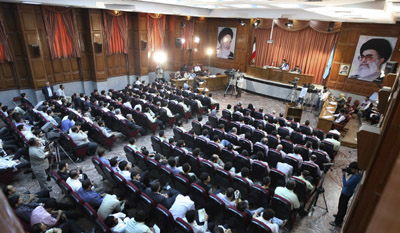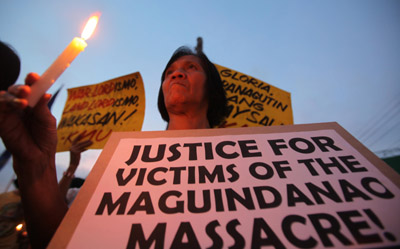Asia
2010

Citizen journalist helped report Philippine massacre
“The e-mail came in at 8.48 p.m.,” Philippine journalist Maria Ressa told a hushed audience at CPJ’s panel discussion, Press Freedom: On the Frontlines and Online, this morning at the Foreign Correspondents Club of Japan in Tokyo. She was describing how the first photo from the November massacre in Maguindanao province reached the mainstream Philippine…

Press freedom, new media in Tokyo
CPJ’s six-city launch of Attacks on the Press began today in Tokyo, where we hosted a panel discussion with Maria Ressa of ABS-CBN TV in the Philippines, Asahi Shimbun deputy foreign editor Nobuyoshi Sakajiri, NHK Middle East correspondent Nobuhisa Degawa, CPJ China expert Madeline Earp, and me.

Attacks on the Press 2009: Preface
By Fareed Zakaria Toward the end of his 118-day ordeal inside Tehran’s Evin prison, Newsweek reporter Maziar Bahari had a bizarre exchange with his interrogator. Bahari had been held in solitary confinement since his arrest after Iran’s disputed presidential election in June; he had been subjected to near-daily beatings and interrogation sessions that stretched for…
Attacks on the Press 2009: Introduction
By Joel Simon Does “name and shame” still work in the Internet age? After all, the massacre of 31 journalists and media workers in the Philippines pushed the 2009 media death toll to the highest level ever recorded by CPJ. The number of journalists in prison also rose, fueled by the fierce crackdown in Iran.

As fighting surges, so does danger to press
By Bob Dietz As the United States redeploys forces to Afghanistan, and the Pakistani military moves into the country’s tribal areas, the media face enormous challenges in covering a multifaceted conflict straddling two volatile countries. Pakistani reporters cannot move freely in areas controlled by militants. International reporters in Afghanistan, at risk from kidnappers and suicide…
Attacks on the Press 2009: Afghanistan
Top Developments • Government tries to curb reporting on Election Day violence. • Abductions target foreign reporters, endangering local journalists, too. Key Statistic 20: Years that Parwez Kambakhsh would have spent in jail on an unjust charge. He was freed in August. Deepening violence, flawed elections, rampant corruption, and faltering development provided plenty of news…
Attacks on the Press 2009: Burma
Top Developments• Some political prisoners freed, but eight journalists still held.• Government censors all print publications, controls broadcasters. Key Statistic 1st: Ranking on CPJ’s Worst Countries to Be a Blogger. Throughout the year, Burma’s ruling junta emphasized its plans to move toward multiparty democracy after decades of military rule, a long-promised transition that dissidents and others…
Attacks on the Press 2009: China
Top Developments• More access for foreign reporters, tighter rules for local assistants.• As online use grows, government censors sites, jails critics. Key Statistic 24: Journalists jailed as of December 1, 2009. While China’s ruling communist party celebrated 60 years in power in 2009, its critics commemorated antigovernment movements in Tibet in 1949 and Tiananmen Square…
Attacks on the Press 2009: Nepal
Top Developments• Government fails to investigate press freedom abuses. • Reporter slain after covering Maoist land seizures. Key Statistic 8th: Ranking on CPJ Impunity Index, making it one of world’s worst for press. Nepal’s news media entered 2009 in a state of crisis. Attacks on the press had escalated in late 2008 amid a climate…
